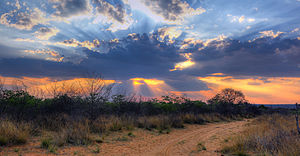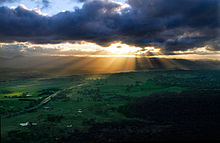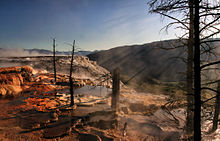
Crepuscular rays /krɨˈpʌskjʉlər/, in atmospheric optics, are rays of sunlight that appear to radiate from the point in the sky where the sun is located. These rays, which stream through gaps in clouds (particularly stratocumulus) or between other objects, are columns of sunlit air separated by darker cloud-shadowed regions. Despite seeming to converge at a point, the rays are in fact near-parallel shafts of sunlight, and their apparent convergence is a perspective effect (similar, for example, to the way that parallel railway lines seem to converge at a point in the distance).
The name comes from their frequent occurrences during crepuscular hours (those around dawn and dusk), when the contrasts between light and dark are the most obvious. Crepuscular comes from the Latin word "crepusculum", meaning twilight.[1]
Anticrepuscular rays
The rays in some cases may extend across the sky and appear to converge at the antisolar point, the point on the sky sphere directly opposite the sun. In this case they are called anticrepuscular rays. These are not as easily spotted as crepuscular rays. This apparent dual convergence (to both the solar and antisolar points) is a perspective effect analogous to railway tracks appearing to converge to opposite points in opposite directions.[2]
Colour
Crepuscular rays are usually red or yellow in appearance because the path through the atmosphere at sunrise and sunset passes through up to 40 times as much air as rays from a high midday sun. Particles in the air scatter short wavelength light (blue and green) through Rayleigh scattering much more strongly than longer wavelength yellow and red light.
Alternative names
- Backstays of the sun – a nautical term, from the fact that backstays that brace the mast of a sailing ship converge in a similar way
- Cloud breaks
- Jacob's Ladder
- Ropes of Maui – (originally. taura a Maui) from the Maori tale of Maui Potiki restraining the sun with ropes to make the days longer
- Shafts of light
- Sun drawing water – from the ancient Greek belief that sunbeams drew water into the sky (an early description of evaporation)
- Sunbeams
- Sunburst
- Volumetric lighting (used by the computer graphics industry)
- God rays (used by the computer graphics industry[3])
-

Crepuscular rays at Black Mountain Tower, Canberra.
-

Crepuscular rays in Golden Gate Park.
-

Anticrepuscular rays opposite the setting sun off the Florida Gulf Coast of the United States.
-
Crepuscular rays at noon in Saint Peter's Basilica, Vatican City.
-

Crepuscular rays in steam from hot springs at Yellowstone National Park.
-

Crepuscular rays at the Dago Waterfall near Bandung, date 1920–1932.
-
This astronaut photograph from the ISS provides an unusual viewing perspective from above some crepuscular rays and a clear illustration of their parallel nature.
-

Jacob's Ladder crepuscular panorama
See also
References
- ^ Edens, Harald, "Crepuscular rays", Weather Photography lightning, clouds, atmospheric optics & astronomy, retrieved November 1, 2011.
- ^ John A. Day (2005), The Book of Clouds, Sterling Publishing Company, Inc., pp. 124–127, ISBN 978-1-4027-2813-6, retrieved 2010-10-09.
- ^ E.g. this term is mentioned in: Jens Krüger; Kai Bürger; Rüdiger Westermann (2006). "Interactive screen-space accurate photon tracing on GPUs". Proceedings of the 17th Eurographics conference on Rendering Techniques (EGSR'06).









